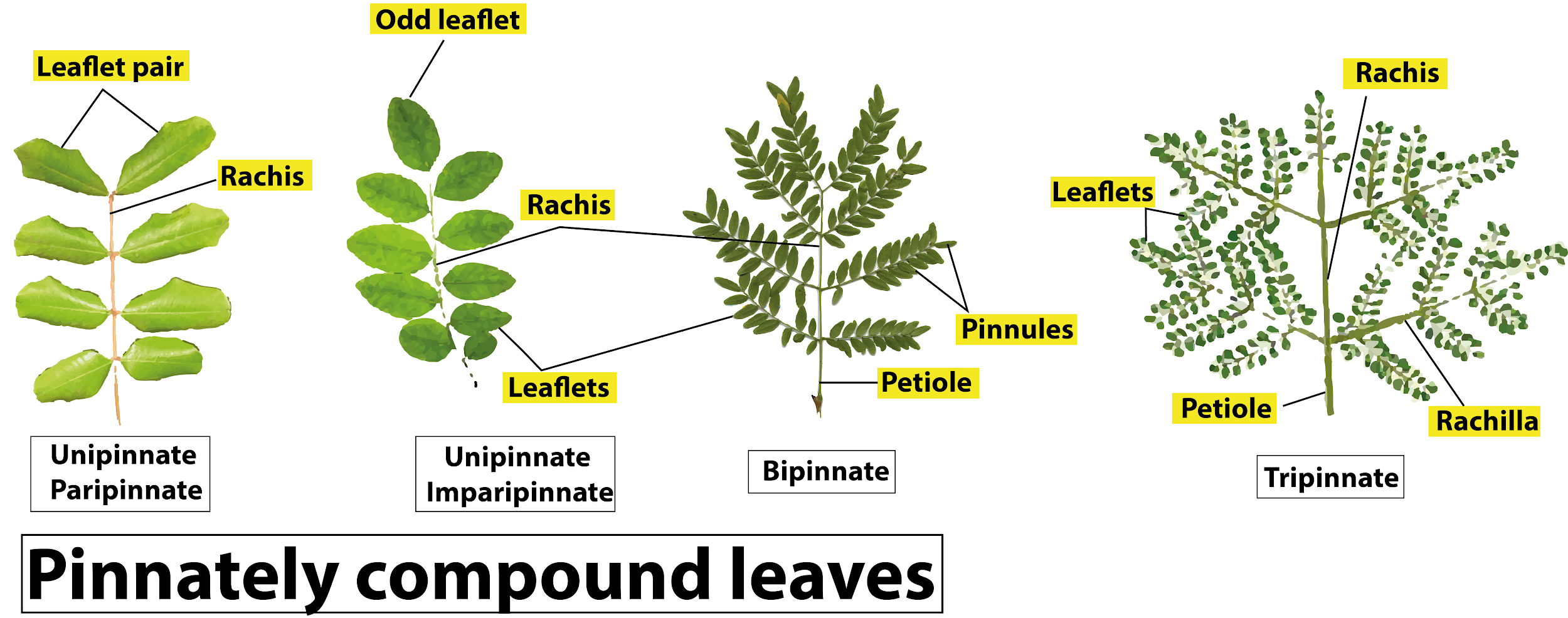
Tripinnate leaves occur in
(a) Acacia
(b) Oxalis
(c) Moringa
(d) Gynandropsis
Answer
569.1k+ views
Hint: Compound leaves are the leaves that show the presence of many leaflets. These can be either pinnate or palmate. In the pinnate type of compound leaves, the leaflets arise on either side of the midrib and based on the leaflet pattern, they are divided into various pinnations. Tripinnate leaves are present in the drumstick trees.
Complete Step by Step Answer:
The term tripinnate means the pinnately compound leaves in which the leaflets are themselves bipinnate. Such an arrangement of the leaflets in the drumstick trees i.e. Moringa oleifera
- Pinnation is the feather- like or multi- divided arrangement of leaflets on both the sides of a common axis.

- This pinnation can be further classified as:
- Unipinnate: It is the simplest form of pinnation in which a single row of leaflets is arranged on both sides of a common axis.
- Bipinnate: In this kind, the leaflets themselves are pinnately compound.
- Tripinnate: In this type of pinnately compound leaves, the leaflets themselves are bipinnate in the arrangement.
- Tripinnate: The pinnately compound leaves have leaflets that are themselves tripinnate.
So, the correct answer is, ‘(c) Moringa.’
Note:
Another form of classifying the pinnation is:
- Paripinnate: In this form of pinnation, the leaflets are present along the rachis as pairs without a single terminal leaflet. It is also called even- pinnate.
- Imparipinnate: In this type of pinnation, there is a lone terminal leaflet that is present at the tip of the rachis and it is also called odd- pinnate.
- Compound leaves can also be Palmately compound in which the leaflets arise from a common petiole.
Complete Step by Step Answer:
The term tripinnate means the pinnately compound leaves in which the leaflets are themselves bipinnate. Such an arrangement of the leaflets in the drumstick trees i.e. Moringa oleifera
- Pinnation is the feather- like or multi- divided arrangement of leaflets on both the sides of a common axis.

- This pinnation can be further classified as:
- Unipinnate: It is the simplest form of pinnation in which a single row of leaflets is arranged on both sides of a common axis.
- Bipinnate: In this kind, the leaflets themselves are pinnately compound.
- Tripinnate: In this type of pinnately compound leaves, the leaflets themselves are bipinnate in the arrangement.
- Tripinnate: The pinnately compound leaves have leaflets that are themselves tripinnate.
So, the correct answer is, ‘(c) Moringa.’
Note:
Another form of classifying the pinnation is:
- Paripinnate: In this form of pinnation, the leaflets are present along the rachis as pairs without a single terminal leaflet. It is also called even- pinnate.
- Imparipinnate: In this type of pinnation, there is a lone terminal leaflet that is present at the tip of the rachis and it is also called odd- pinnate.
- Compound leaves can also be Palmately compound in which the leaflets arise from a common petiole.
Recently Updated Pages
Master Class 12 Business Studies: Engaging Questions & Answers for Success

Master Class 12 Economics: Engaging Questions & Answers for Success

Master Class 12 English: Engaging Questions & Answers for Success

Master Class 12 Maths: Engaging Questions & Answers for Success

Master Class 12 Social Science: Engaging Questions & Answers for Success

Master Class 12 Chemistry: Engaging Questions & Answers for Success

Trending doubts
What is meant by exothermic and endothermic reactions class 11 chemistry CBSE

Which animal has three hearts class 11 biology CBSE

10 examples of friction in our daily life

One Metric ton is equal to kg A 10000 B 1000 C 100 class 11 physics CBSE

1 Quintal is equal to a 110 kg b 10 kg c 100kg d 1000 class 11 physics CBSE

Difference Between Prokaryotic Cells and Eukaryotic Cells




